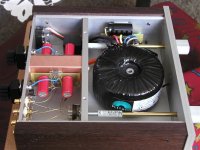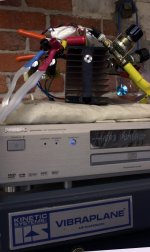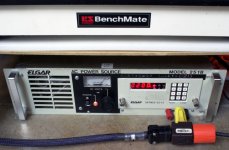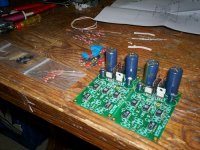i still have one of your lm4780 kits, could it be implemented
to fit in this case if i dont run the rails to high?
im interested
😀
to fit in this case if i dont run the rails to high?
im interested
😀
The chassis is big enough to dissipate heat from parallel version of LM4780, you can run the rails to the limit.
LM4780 PCB also fits in that chassis. I've built few amps using that chip here.
LM4780 PCB also fits in that chassis. I've built few amps using that chip here.
Member
Joined 2002
Peter, it looks like you have completely stopped wiring the amp boards with all wires from the PSU, similar to the Patek.
Josh
Josh
Peter Daniel said:This amp has additional toggle switch at the back that disconnects the pot completely from signal path. One set of inputs is connected directly to amp's input on the board, so it can be configured in power amp mode only (bypassing source selector and potentiometer).
Nice feature.
Great looking amp.
I'm thinking of starting a thread for "The Ugliest DIY Amp Contest"...
Who could beat this? (The EVS Nude attenuators work great with it.)
Attachments
200Hz Regenerated power and the Gainclone
I hate to tell ya', but you haven't heard what the LM3875 can do until you've heard it driven with 200Hz power.
I was playing Hans Zimmer's GLADIATOR soundtrack today and was wondering if I was restricting bass extension and dynamics at all powering the Gainclone via my Elgar power regenerator.
The Elgar 251B is a lab grade power regenerator capable of 250VA at 400Hz. With the 9012 controller you can select any voltage and any frequency up to 400Hz. The PS Audio Power Plants are largely the same thing, but go to 120Hz, and offer Multiwave options. I have a P300 with Multiwave, and it's not nearly as much power as the Elgar, and actually doesn't sound as good on amps. Multiwave is great for front end components though.
The Elgars do have noisy fans that need to be padded down to make them quiet if they're kept in the listening room. I also have the smaller Elgar 121B, which is great for front-end components and even small amps like a 2A3, but doesn't really have enough current to drive most amps hard.
Now granted, the toroid on my Gainclone is 400VA, (and rated to 400Hz), but with my 97dB efficient line arrays, the Peter Daniel Gainclone barely warms up, even at insane volumes.
None the less, when I went straight into the wall versus powering from the Elgar at 90Hz, it seemed I was losing a little bit of bass energy, (if you know this soundtrack, that's easy to do).
So I started working up the power frequency on the Elgar. At 200Hz I got all the magic of regenerated power, better detail, timbre, imaging, but also restored the full bass and dynamic impact of the straight wall connection. (200Hz also makes the amp seem insanely fast, highs sound like a Halcro.)
Had me laughing out loud it sounded so good.
The Elgar:
I hate to tell ya', but you haven't heard what the LM3875 can do until you've heard it driven with 200Hz power.
I was playing Hans Zimmer's GLADIATOR soundtrack today and was wondering if I was restricting bass extension and dynamics at all powering the Gainclone via my Elgar power regenerator.
The Elgar 251B is a lab grade power regenerator capable of 250VA at 400Hz. With the 9012 controller you can select any voltage and any frequency up to 400Hz. The PS Audio Power Plants are largely the same thing, but go to 120Hz, and offer Multiwave options. I have a P300 with Multiwave, and it's not nearly as much power as the Elgar, and actually doesn't sound as good on amps. Multiwave is great for front end components though.
The Elgars do have noisy fans that need to be padded down to make them quiet if they're kept in the listening room. I also have the smaller Elgar 121B, which is great for front-end components and even small amps like a 2A3, but doesn't really have enough current to drive most amps hard.
Now granted, the toroid on my Gainclone is 400VA, (and rated to 400Hz), but with my 97dB efficient line arrays, the Peter Daniel Gainclone barely warms up, even at insane volumes.
None the less, when I went straight into the wall versus powering from the Elgar at 90Hz, it seemed I was losing a little bit of bass energy, (if you know this soundtrack, that's easy to do).
So I started working up the power frequency on the Elgar. At 200Hz I got all the magic of regenerated power, better detail, timbre, imaging, but also restored the full bass and dynamic impact of the straight wall connection. (200Hz also makes the amp seem insanely fast, highs sound like a Halcro.)
Had me laughing out loud it sounded so good.
The Elgar:
Attachments
A little off topic, sorry.
Rob, Sorry, but I think I take the cake for ugliest project, with my first DIY project ever. This is quite embarassing, but here is my first GC. And I can't stress more that, it was 5 days after my 16th birthday and that I have learned from my mistakes.
Josh
Rob, Sorry, but I think I take the cake for ugliest project, with my first DIY project ever. This is quite embarassing, but here is my first GC. And I can't stress more that, it was 5 days after my 16th birthday and that I have learned from my mistakes.
Josh
An externally hosted image should be here but it was not working when we last tested it.
Josh,
You need SOME KIND of heatsink for the chips (or is it just not added yet?) You don't need much , but something! Just worried for your components 😉
You need SOME KIND of heatsink for the chips (or is it just not added yet?) You don't need much , but something! Just worried for your components 😉
Variac,
I appriciate your concern. That amp lasted a total of about 7 days before a cap blew and this happened (picture below). It actually had a heatsink, but the heatsink was not large enough. By the end of break in, the amplifier was playing mostly FM radio, when my CD player was plugged into it. I learned a little about GC, then I started building it. After Brian began helping me, I got much better, and ended up writing the rough draft for the LM3886 kit instructions.
After my GC stopped working I met with BrianGT, who taught me all the basics. Ever since then my work has been much better. Since that incident I have learned to keep wire length as short as possible. (See picture below of new amps wiring).
Thanks,
Josh
I appriciate your concern. That amp lasted a total of about 7 days before a cap blew and this happened (picture below). It actually had a heatsink, but the heatsink was not large enough. By the end of break in, the amplifier was playing mostly FM radio, when my CD player was plugged into it. I learned a little about GC, then I started building it. After Brian began helping me, I got much better, and ended up writing the rough draft for the LM3886 kit instructions.
An externally hosted image should be here but it was not working when we last tested it.
After my GC stopped working I met with BrianGT, who taught me all the basics. Ever since then my work has been much better. Since that incident I have learned to keep wire length as short as possible. (See picture below of new amps wiring).
An externally hosted image should be here but it was not working when we last tested it.
An externally hosted image should be here but it was not working when we last tested it.
Thanks,
Josh
Hi Peter. Please contact me over email. I want ot buy some integrated enclosures.
Thanks...
Algar_emi
Thanks...
Algar_emi
OT: Karma's Kodak
Pretty good image for 100K. Does it have macro close-up ability? It's great for shooting circuit-boards and such...
karma said:testing the new kodak😀
Pretty good image for 100K. Does it have macro close-up ability? It's great for shooting circuit-boards and such...
Re: OT: Karma's Kodak
kodak easyshare model c530 5.0 mega pixels zoom lens.
it was on sale for $160.00
Rob Thomas said:
Pretty good image for 100K. Does it have macro close-up ability? It's great for shooting circuit-boards and such...
kodak easyshare model c530 5.0 mega pixels zoom lens.
it was on sale for $160.00
angchuck said:Is this the buffer?
yup thats peters buffer,all thats left is the resisters
😉
- Status
- Not open for further replies.
- Home
- More Vendors...
- Audio Sector
- AudioSector-chip amp kits, dacs, chassis



